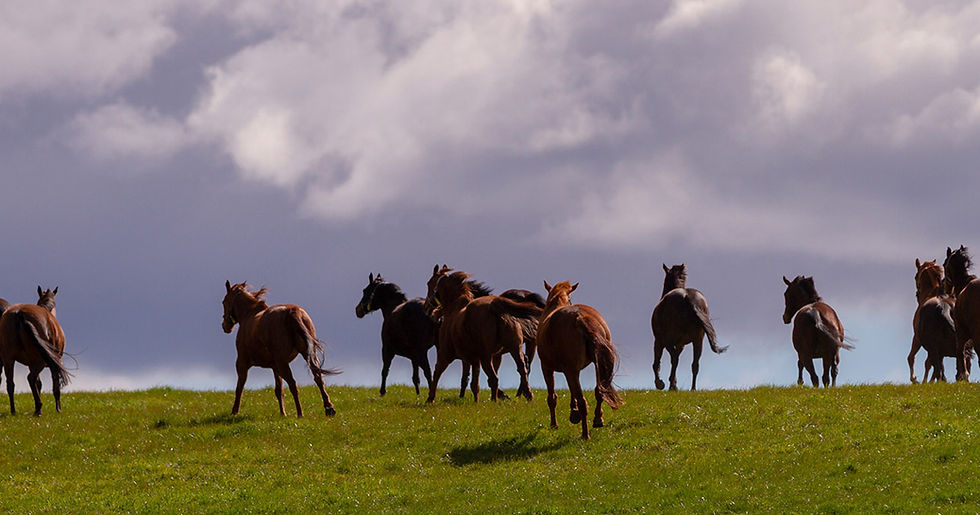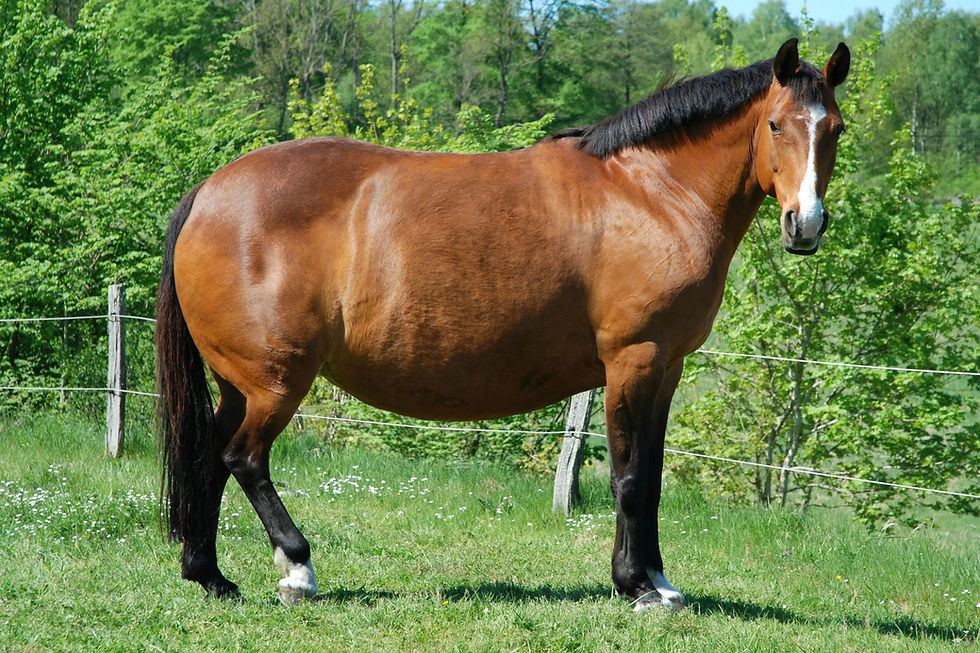Horses in motion.
- Mar 16
- 5 min read
The number one function of a horse's body is movement. All body systems, whether respiratory, digestive, neurological or reproductive, are at their best when a horse is moving freely. Horses need movement for a healthy metabolism, hoof health and mental well-being.

Horses can gallop within hours of being born. They were literally born to be on the move! They have evolved over the last 55 million years with a strong innate need for movement, and their physiological makeup has evolved to support this. Horse herds have evolved to never stop moving or eating for long periods of time.

In the wild, they tend to live in areas where grass and water are scarce and in order to survive, movement occurs naturally throughout the day as they move around in search of forage and other resources. They also move while playing and establish a hierarchical order in their social life. It is said that wild horses can travel more than 50 km per day.

The horse's gastrointestinal tract is one of the body systems most easily disrupted by lack of movement. When a horse is confined the process known as peristalsis (intestinal muscle contractions that digest and move food along the digestive tract) is disrupted, leaving your horse prone to ileus (intestinal immobility). This in turn can lead to intestinal impaction and colic.

In addition to impairing digestion, lack of exercise contributes to obesity, which goes hand in hand with other serious health problems for horses, including laminitis and endocrine disorders such as insulin resistance and equine metabolic syndrome.

In horses, the heart is
relatively small compared to their body, so they also need movement to receive help from the muscles, joints and hooves to maintain blood flow through the body.
When a horse is stabled, the circulatory system does not function at full capacity and the heart can be subjected to excessive stress. It also tends to worsen when given short but intense exercise.

Regular physical activity also increases bone density and strength, as well as promoting the strength and development of muscles, tendons and ligaments, which is especially important for foals and young horses, resulting in stronger, healthier horses.

One of the consequences of modern horse domestication is a profound reduction in daily physical activity. Even horses that work regularly and are in top physical condition probably get much less exercise than their wild counterparts.
In today's society, the value of movement for the body has been relegated to forced and regimented exercise, and so the slow, steady movement of daily activity has lost value. However, the difference between exercise and movement varies greatly in relation to overall health and well-being.

Exercise, physical activity, and movement are all different ways of using the body. While the words have different associations for different people, exercise generally involves a structured regimen of repetitive physical activities with a training focus, while movement is physical activity that occurs during everyday life.

Movement can be thought of as the activities that move the horse throughout its daily life. Due to the nature of a fibrous diet, this must include a large number of strides and chewing cycles to ingest sufficient volume. Ironically, research has shown that horses do not require regimented daily exercise to remain fit, but they do require an environment that provides plenty of opportunity for movement to maintain a natural level of fitness.
The field of exercise was born to respond to the harmful effects of a sedentary lifestyle on the body that modern and contemporary life has. As a result, many people have come to prioritize exercise over movement due to a fast-paced and time-limited lifestyle.
This philosophy has spread widely to the equine world, where many horses also live a sedentary existence with brief bouts of intense exercise.

As a result, many horse owners focus on their animals' exercise and training program and overlook the value of overall movement to their biology. Contemporary human cultures and suburban equine cultures, while convenient, frequently result in monotonous, repetitive activity that lacks variety. This becomes a biological burden on both the human and equine body to such an extent that it dramatically decreases the quality and length of life and leads to a host of health problems.
Today's horses suffer from many of the same health problems as today's humans and pets.
As the horse's ability to fully express its movements is limited, all body systems are affected to varying degrees. Obesity is the most obvious consequence, but so are metabolic sequelae such as insulin resistance, equine metabolic syndrome and the dreaded laminitis.

Lack of mobility also contributes to poor hoof quality, moving through varied terrain stimulates the hooves and conditions them at the same time. Gravel is good for this, especially gravel . If the horse is ridden enough miles, the hooves will begin to support themselves. In the wild, hills and rocks will help develop the tendons, muscles and hooves, which will help the horse walk more confidently.

Other consequences of limited movement include skin diseases, digestive disorders such as ulcerations, colic and impaction, loss of natural behaviour, loss of muscle tone, reproductive failure, development of stereotyped behaviour and a general decline in physical condition and well-being.
Exercise and training programs for horses typically focus on the larger musculoskeletal groups, but the highly refined connective and neurological tissues critical to respiration, fluid circulation (blood and lymph), digestion and reproductive systems, and hoof and dental health are highly invested in the results of daily movement to remain healthy.
In addition, the immune functions of the lymphatic system are closely related to the daily movements of the body.

Movement is so crucial to the horse's biology that when it is lacking, it leads to problematic behaviors, such as stall-confined horses, which often display stereotypes such as biting, gulping air, chewing wood, or pacing the stall as the animal attempts to satisfy the need to move even when prevented from doing so.
Horses confined with restricted movement for long periods can easily become bored or anxious. Lack of forage is another major reason why horses develop stereotypical behaviors.

Replicating the horse's natural living conditions through movement, social life and free choice of forage helps mitigate these behaviors.
For example: keeping horses outside instead of in a stable or box.
Release them in larger fields rather than smaller paddocks, always in groups rather than alone, to encourage movement and interaction.
Consider implementing natural runway systems (Padock paradise) in fields to encourage movement and feeding well away from the water source, i.e. water at one end of the paddock and forage at the other.
For horses, the most beneficial thing is to increase group movement and general daily physical activity. Small changes can have a very positive impact on your horse's health, strength and longevity.

Sources: Jenny Edwards (Natural Horse Care), Lucile Vigouroux (Equine Journalist), Camilla Whishaw (Naturopath), Carol Shwetz (Veterinarian), Florida Equine Veterinary Associates.


Comments